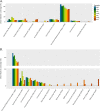Corallivory and the microbial debacle in two branching scleractinians
- PMID: 29339825
- PMCID: PMC5864218
- DOI: 10.1038/s41396-017-0033-5
Corallivory and the microbial debacle in two branching scleractinians
Abstract
The grazing activity by specific marine organisms represents a growing threat to the survival of many scleractinian species. For example, the recent proliferation of the corallivorous gastropod Drupella now constitutes a critical case in all South-East Asian waters. If the damaging effects caused by this marine snail on coral polyps are relatively well known, the indirect incidence of predation on coral microbial associates is still obscure and might also potentially impair coral health. In this study, we compared the main ecological traits of coral-associated bacterial and viral communities living in the mucus layer of Acropora formosa and Acropora millepora, of healthy and predated individuals (i.e., colonized by Drupella rugosa), in the Bay of Van Phong (Vietnam). Our results show a substantial impact of the gastropod on a variety of microbiological markers. Colonized corals harbored much more abundant and active epibiotic bacteria whose community composition shifted toward more pathogenic taxa (belonging to the Vibrionales, Clostridiales, Campylobacterales, and Alteromonadales orders), together with their specific phages. Viral epibionts were also greatly influenced by Drupella corallivory with spectacular modifications in their concentrations, life strategies, genotype richness, and diversity. Novel and abundant circular Rep-encoding ssDNA viruses (CRESS-DNA viruses) were detected and characterized in grazed corals and we propose that their occurrence may serve as indicator of the coral health status. Finally, our results reveal that corallivory can cause severe dysbiosis by altering virus-bacteria interactions in the mucus layer, and ultimately favoring the development of local opportunistic infections.
Conflict of interest statement
The authors declare that they have no conflict of interest.
Figures








References
-
- Maynard J, Van Hooindonk, Eakin CM, Puotinen M, Garren M, Willimans G, et al. Projections of climate conditions that increase coral disease susceptibility and pathogen abundance and virulence. Nature Clim Change. 2015;5:688–94. doi: 10.1038/nclimate2625. - DOI
Publication types
MeSH terms
LinkOut - more resources
Full Text Sources
Other Literature Sources
Research Materials

